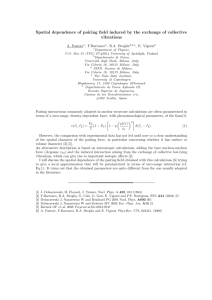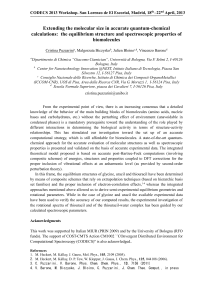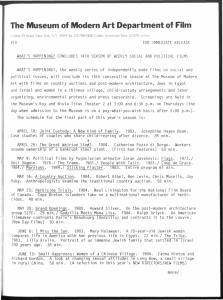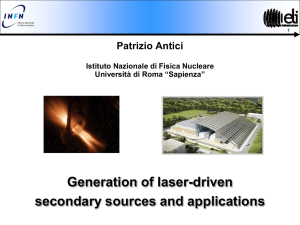Size Effects on Polarization in Epitaxial Ferroelectric Thin Films
advertisement
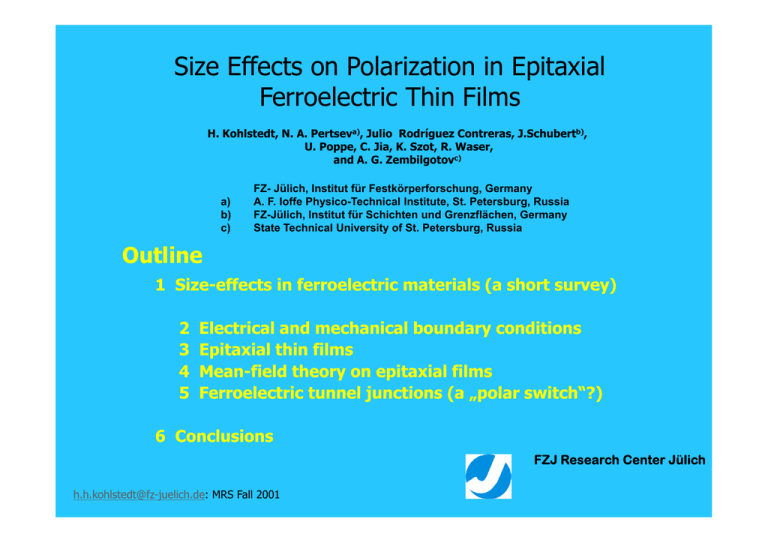
Size Effects on Polarization in Epitaxial Ferroelectric Thin Films H. Kohlstedt, N. A. Pertseva), Julio Rodríguez Contreras, J.Schubertb), U Poppe, U. Poppe C. C Jia, Jia K. K Szot, Szot R. R Waser, Waser and A. G. Zembilgotovc) a) b) c) FZ- Jülich, Institut für Festkörperforschung, Germany A. F. Ioffe Physico-Technical Institute, St. Petersburg, Russia FZ-Jülich, Institut für Schichten und Grenzflächen, Germany State Technical University of St. Petersburg, Russia Outline 1 Size-effects in ferroelectric materials (a short survey) 2 3 4 5 Electrical and mechanical boundary conditions Epitaxial thin films Mean-field theory on epitaxial films Ferroelectric tunnel junctions (a „polar polar switch switch“?) ?) 6 Conclusions FZJ R Research hC Center t Jüli Jülich h h.h.kohlstedt@fz-juelich.de: MRS Fall 2001 1 Size-effects in ferroelectric materials Lateral L t l 2D: 2D - individual i di id l capacitors it on substratesbt t Top down, FIB 200 nm x 200 nm Bottom up/top down etch free fabrication 75 nm dots Polarizatio on S. Tiedke, A. Roelofs, T. Sc Schmitz, t , K. Prume, u e, T. Schneller, U. Kall, C.S. Ganpule, A. Stanhishevsky, R. Ramesh, and R. Waser, APL, 79 3678, 26 Nov. 2001 Bottom up: CSD-self assembled 70 nm grain M. Alexe et al. APL 75, 1793 (1999). and APL 79, 79 242 (2001). (2001) Studyy of individual pproperties p In Powders: only averaging possible A. Roelofs, T. Schneller, F. Schlaphof 2000 2 2 Pertsev Ghosez and Rabe (PTO) Abe (PZ ZT); Yoneda a (BTO) Li et al. L J. Scott Symetrix (PZT) 10 Sayer (PZT) 100 Tyybell (PZT) 6 4 an (TGS) Batra and Silverma Thick kness Lim mit (nm) 1000 Bune (PVF2) (nm) 8 Karasawa (P PTO) 10 Marayuma (P PZT) Film Thickness: historical survey – some milestones Li et al. L 1 Size-effects Size effects in ferroelectric thin films monolayer of oxide (0.4 nm) 0 1996 1997 1998 1999 2000 2001 1 1970 1975 1980 1985 1990 1995 2000 Year of Publication ??Whyy does this trend exists?? 3 Boundaryy conditions (for thin films) Dead layer and/or Surface layer Top electrode Ferroelectric film Bottom electrode S b t t Substrate A Electrical boundary B Mechanical/compositional boundary Scaling: Interfaces become more important !! 4 A: Electrical Boundary Conditions Milestones: Polarization P Depolarization field ++++++++++++ ED Batra and Silvermann, Solid State Comm. 11, 291 (1972). d > 400 nm due to depolarization ____________ R. Kretchmer and K. Binder, Phys. Rev. B 20, 1065 (1979). ρ = div P inhomogeneous polarization distribution at interface Tilley and Zêks, Solid State Comm., 49, 823 (1984) Thomas-Fermi Thomas Fermi screening length M_ _l _ _ _ _ _ _ _ _ _ _Metal ++++++++++++ ED ____________ ++++++++++++ no complete compensation Y. Watanabe, Phys. Rev. B 57, 789 (1998). depolarization field vanishes (ferroelectric has finite conductivity) Metal FZJ Research Center Jülich 5 B: Mechanical/Compositional Boundary Conditions Device structure I Noble metal electrodes Dead layer formation, Pr = 0 High angle grain boundaries High-angle Device structure II Epitaxial (single crystal) electrodes and Fe Fe-Films Films on single crystal oxide substrates Surface layer, Pr Platinum/IrOx SrRuO3 PZT, BTO PZT, BTO Platinum/IrOx / SrRuO3 Si-Substrate (CMOS) SrTiO3 non-ideal situation, complicated, difficult to reach by theory approach for ideal situation, may be accessible by theory Best approach for application, Combination Co b a o with CMOS C OS Technology, o ogy, Good retention, fatigue and imprint data!! P∞ Best approach to study finite ssize effectss in ferroelectric thin films 6 B: Mechanical/Compositional Boundary Conditions Device structure II Epitaxial (single crystal) electrodes and Fe-Films on single crystal oxide substrates Milestones: (thin film deposition-devices) R. Ramesh et al., Appl. Phys. Lett 59, 3542 (1991). PbZr0.2Ti 0.803/YBaCuO/LaAlO3-Substrate C. B. Eom et al. Science 258, 1766 (1993). SrRuO3 as electrode on SrTiO3-Substrate C. B. Eom et al. Appl. Phys. Lett. 63, 2570 (1993). SrRuO3 /PbZr0.52Ti0.48 03/ SrRuO3 - Fe-Capacitors Th. Tybell, C. H. Ahn, and J.-M. Triscone, Apl.Phys. Lett. 75, 856 (1999). 4 nm PbZr0.2Ti0.803 on Nb:SrTiO3 are ferroelectric 7 The concept of extrapolation length (free standing film) R. Kretschmer and K. Binder, Phys. Rev. B20 B20,, 1065 (1979). interface region outer part P interface region P inner part P∞ P∞ correlation length ξ ρ extrapolation t l ti length l th x ρ > 0: P decreases at interface x ρ < 0: P increases at interface 8 I t i i effect Intrinsic ff t off fil film surfaces f Mean fieldfield-theory + Concept of extrapolation length δ: ¾ ¾ ¾ ¾ ¾ R. Kretschmer and K. Binder, Phys. Rev. B20 B20,, 1065 (1979). D. R. Tilley and B. Žekš, Solid State Comm. Comm. 49 49,, 823 (1984). J. F. Scott, H. M. Duiker, P. D. Beale, B. Pouligny, K. Dimmler, M. Parris, D. Butler, and S. Eaton, Physica B150 B150,, 160 (1988). W. L. Zhong, B. D. Qu, P. L. Zhang and Y. G. Wang, Phys. Rev. Rev. B50,, 12375 (1994). B50 S Li S. Li, J. J A A. Eastman Eastman, Z. Z Li, Li C. C M. M Foster, Foster R. R E. E Newnham, Newnham and L. L E. E Cross, Phys. Lett. Lett. A212 A212,, 341 (1996). Free-standing films only! Freeonly! Substrate--induced strains in epifilms ignored! Substrate 9 The concept of extrapolation length (free film) interface region P outer part P∞ Substrate 2D-clamping, compressive case inner part correlation length ξ ρ extrapolation length ρ > 0: P decreases at interface Unit cell of BaTiO3, Pb (ZrTi) O3 x Enhancement of P possible Sm = (b – a0)/b b = substrate subst ate lattice att ce pa parameter a ete a0 = equiv. cubic cell constant of free film, Prototypic cell Sm: Misfit f strain 10 EXTRINSIC SIZE EFFECT OF MECHANICAL ORIGIN Lattice misfit between film and substrate H ≤ H* : ⇒ Misfit strain Sm Sm = (b – a0)/b – independent of film thickness H! b = substrate lattice parameter a0 = equivalent cubic cell constant of free standing film H > H*: Sm = (b* – a0)/b* - becomes thickness-dependent! Substrate effective lattice parameter b*: [J. S. Speck, W. Pompe, J. Appl. Phys. 76, 466 (1994)] ⎡ (b − a0 ) ⎛ H * ⎞⎤ b * ( H ) ≈ b ⎢1 − ⎜1 − ⎟ b ⎝ H ⎠⎥⎦ ⎣ Polarization Ps = function of Sm [N. A. Pertsev, A. G. Zembilgotov, A. K. Tagantsev, Phys. Rev. Lett. 80, 1988 (1998)] ⇒ Thickness dependence of Ps via Sm(H) at H > H*! 11 Ferroelectricity in ultrathin films on compressive substrates (I) A. G. Zembilgotov, N. A. Pertsev, H. Kohlstedt, and R. Waser, cond cond--mat/ mat/0111218; 0111218; J. Appl A l. Phys Appl. Ph . 89 (2002 Phys. 2002)) (in (i press). press)). Total Helmholtz free energy of inhomogeneously polarized film film:: H /2 ℑ/ A = ∫ F ( z )dz + −H / 2 ( 1 g11δ −1 P−2 + P+2 2 ) S m2 1 ⎛ dP ⎞ * F ( z) = + a3* ( S m ) P 2 + a33 P 4 + a111 P 6 + g11 ⎜ ⎟ s11 + s12 2 ⎝ dz ⎠ 2Q Q12 a = a1 − S m s11 + s12 * 3 2 Q122 a = a11 + s11 + s12 * 33 Sm = misfit strain Q12 = electrostrictive constant sij = elastic compliances 12 Ferroelectricityy in ultrathin films on compressive p substrates ((II)) Polarization profile P(z) and mean polarization via EulerEuler-Lagrange equation: 1.0 d 2P * P 3 + 6a111 P 5 g11 2 = 2a3* P + 4a33 dz ⇒ Size effect is governed by normalized film thickness H/ξ* and ratio δ/ξ*! | Mean polariza ation, P/Ps 0.8 0.6 0.4 0.2 ξ * = g11 / a3* - modified correlation length ((function of misfit strain!)) 0.0 0 2 4 6 8 10 12 14 * Relative film thickness, H/ξ Compare: ξ = g / a 11 1 = bulk correlation length 13 The concept of extrapolation length (free film) o te pa outer partt P∞ P p g Clamping inne part inner pa t correlation length ξ ρ extrapolation length x ρ > 0: P decreases at i t f interface negative surface effect Polarization enhancement 14 Competition between surface and strain effects 620 40 nm B TiO3 BaTiO 0.38 2 580 560 540 | bulk 520 2 5 10 20 500 480 460 440 420 400 Mean polarizatio M on P, C/m Tran nsition temperatture Tc, °C 0.40 PbTiO3 600 thick film 0.36 0.34 12 nm 0 32 0.32 0.30 1 2.6 8.6 0.28 bulk 0.26 0.24 0.22 380 -5 -4 -3 -2 -1 0 -3 Misfit strain Sm, 10 Tc((film)) > Tc ((bulk)) even in ultrathin films! (Numbers give the normalized thickness H/ξ0) 0.20 -30 -25 -20 -15 Misfit strain Sm, 10 -10 -5 -3 P(film) > P (bulk) even in ultrathin films! Circles give remanent polarizations observed in BaTiO3 films grown on SrRuO3 / SrTiO3 N. Yanase, K. Abe, N. Fukushima, T. Kawakubo, Jpn. J. Appl. Phys. 38 38,, 5305 (1999). 15 Ultra-thin Ultra thin ferroelectric films and Quantum Mechanical Tunneling The concept of Ferroelectric Tunnel Junctions: FTJs SrRuO3 Ferroelectric-Film SrRuO3 t < 6 nm Quantum mechanical electron tunneling cannot be ignored !! Large (tunneling) leakage current makes measurements with Sawyer-Tower circuit difficult!! 16 E Tunneling effect -ikx Ψ∝ e k Barrier EB Tunneling Propability: ⎛ 2 t ⎞ P( Ex ) = A ⋅ exp ⎜ − ∫ 2m ⎡⎣φ ( x,V ) − Ex ⎤⎦ dx ⎟ ⎝ h 0 ⎠ El Electrode1 d 1 El Electrode d 2 0 t Barrier B i t Tunneling Current: I (V ) = ∫ ρ1 ( E ) ρ2 ( E − eV V ) ⎡⎣ f ( E − eV V ) − f ( E ) ⎤⎦ M ( E ) dE 2 FZJ Research Center Jülich EF,1 φ0 eV EF,2 17 Ferroelectric Tunnel Junctions Motivation and first Results: A polar switch? Interplay between Tunneling and Polarization? Metal Pb2+ Tunnel current ± Pr O2- e- Zr4+/Ti4+ Metal P Current “1” ? Vc E “0” Vc Voltage Æ Itunneling = f (U, d, EB,A,… Ec, P) ??? 18 Simplified band diagram of FTJ c-axis Ba (1) Ti (2) O χ Estimation: Ec = 200 kV/cm (thick film) U (x) E EF1 φ1 φ2 eVbias EF2 Eg SrRuO3 SrRuO3 x bottom electrode BaTiO3 Barrier thickness t = 5 nm Vc = 100 mV!! (only correct if Ec is thickness independent) top electrode t< 6 nm 19 Ferroelectric Tunnel Junctions First Results: High-Resolution TEM, C. Jia-FZ-Jülich SrRuO3 PZT SrRuO3 SrRuO3 4 nm PZT SrRuO3 4 nm SrTiO3 More details about layer deposition and tunnel junction fabrication are in: C 6.5 /O5.8 this session at 4:15 pm by Julio Rodríguez Contreras and d Poster Session: Today, 8:00 PM, Exhibition Hall D, O6.10/C8.10 by Jürgen Schubert 20 Ferroelectric Tunnel Junctions First Results: Tunnel junctions with oxides materials: (other fields) Superconducting tunnel junctions: I Bosovic and J. I. J N. N Eckstein J. of Alloys and Compounds 251, 201 (1997). (extremely difficult) I+ FTJ V- ISiO2 V+ V SRO BaTiO3 SRO Magnetic tunnel Junctions: Y. Lu et al. Phys. Rev. B 54, 8357 (1996). IBM Yorktown LCMO SrTiO S TiO3 LCMO Note: the terms superconducting and magnetic are related to electrode properties. Whereas: Ferroelectric (tunnel junction) is related to a barrier property 21 Ferroelectric Tunnel Junctions STO (substrate) SrRuO3/PbZr0.52Ti0.48(5nm)/Pt (top) Typical virgin curve Conductance vs vs. V Electric Field E (kV/cm) -1000 1,5 0 1000 Asymmetric barrier heights ! 2000 1,75 #3 - 5 nm PZT FTJ 2/7 300 K 0,5 dI/dU (a.u.) nt (mA) Curren 1,0 A 0,0 , RA= 760 Ω -0,5 B RB= 580 Ω -1,0 B 1,50 A start -1,5 stop -0,5 0,0 0,5 Voltage (V) 1,0 -0,1 0,0 0,1 Voltage U (V) Watanabe et al. 1994 – 1998 (APL, PRB) Explanations: (a) electro migration ((b)Trapping/detrapping ) pp g/ pp g of carriers due to band bending g !! Two point measurement/100 nm and 200 nm ferroelectric films!! 22 Ferroelectric Tunnel Junctions SrRuO3/BaTiO3(5nm)/SrRuO3 Ovonic device: based on Chalcogenide alloys Amorphous-crystalline transition 500 nm Electric Field E (kV/cm) -1000 0 1000 Currennt (mA) 1,0 #14 - 6 nm BTO FTJ 10/11 T = 300 K Beck et al. APL 77,, 139 (2000). ( ) IBM-Zürich Based on: SRO/SrZrO3:Cr/SRO Charging g g and decharching of traps 300 nm 4 5 0,5 3 00 0,0 2 Vs = 670 mV 6 -0,5 1 7 -1,0 -1000 -500 (resistive switching) Stanford R. Ovshinsky, Phys. Rev. Lett. 21, 1450 (1968) I-V after poling: -1.2 -1 2 V, V 500 ms -2000 Other MIM structures 0 Voltage (mV) 500 Ferroelectric origin?? 1000 L. Esaki et al. IBM Technical Disclosure Bull. Bull 13, 2161 (1971). POLAR SWITCH Nb/bismuth niobate/Bi May be ferroelectric origin 23 Ferroelectric Origin of switching? Es = 1000 kV/cm: switching fied General tendency for critical field: t ⇓ Ec⇑ Thick film: 200 nm Ec = 100 kV/cm Thin film: 12 nm Yanase et al al. Jpn. J. Appl. Phys. 38, 5305 (1999). Ec = 600 kV/cm! Ultra-thin film: 5 nm Ec = 1000 kV/cm Not unrealistic 24 Ferroelectric Origin of switching? Butterfly curve Piezoelectric effect? Strain, expansion z Rtunneling ∼ exp (-t(V)...) Electric Field E (kV/cm) Field -2000 -1000 0 1000 Current (mA)) C 1,0 #14 - 6 nm BTO FTJ 10/11 T = 300 K Current 4 5 05 0,5 3 0,0 2 Vs = 670 mV 6 -0,5 1 Field 7 -1,0 -1000 1000 -500 500 0 500 1000 Voltage (mV) 25 Ult thi fil Ultrathin films under d external t l electric l t i field fi ld Metal BaTiO3, PZT, or others Metal Tunnel current cannot be ignored B. Meyer and D. Vanderbilt: Phys. Rev. B 63, 205426 (2001). S. Tinte and M. G. Stachiotti, Phys. Rev. B 64, 235403 (2001). A G. A. G Zembilgotov et al al. cond cond-mat/0111218, mat/0111218 J. J Appl. Appl Phys. Phys 89 (2002) in press. press 26 Conclusions • The mean-field approach: Expitaxial films down to 2 nm can be ferroelectric • At film thicknesses less than 6 nm quantum t mechanical h i l tunneling t li can nott be b ignored i d– this is important for any theoretical and experimental consideration • Relation between Tunneling and Polarization? • First ferroelectric tunnel junctions were prepared and I-V curves showed switching events. • It is not clear whether this switching g events have a ferroelectric origin g – electromigration/creeping (or other effects) are may be present Acknowledgement: This work is supported by the Volkswagen Stiftung and the HGF-Strategiefonds “Piccolo”. FZJ R Research hC Center t Jüli Jülich h 27
